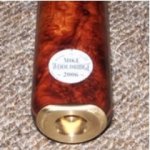Hi guys,
I live in England and play on 7x4ft English tables with 2in balls. We generally use 17-18oz cues with 8-9mm tips and the better cues are generally 1 piece or 3/4 split. The only cues that you ever see over here that use bumpers or pads are the cheap £25 mass manufactured 'tat' that get imported from the far east. No self respecting player of any skill level would ever consider using one of these cues. The top playing cues 9 times out of 10 have a brass plate or insert in the butt that allows for a screw in extension.
So what I'm wondering is this;
Why are bumpers ALWAYS used on your American cues, even the mega $$$ ones?
This might seem like a stupid question (and I apologise if it is) to you guys but I just don't see the point when they aren't necessary (or are they?)
I hope someone can enlighten me with knowledgeable responses. :thumbup:
Thanks to anyone who takes the time to help me understand this.
Exile
I live in England and play on 7x4ft English tables with 2in balls. We generally use 17-18oz cues with 8-9mm tips and the better cues are generally 1 piece or 3/4 split. The only cues that you ever see over here that use bumpers or pads are the cheap £25 mass manufactured 'tat' that get imported from the far east. No self respecting player of any skill level would ever consider using one of these cues. The top playing cues 9 times out of 10 have a brass plate or insert in the butt that allows for a screw in extension.
So what I'm wondering is this;
Why are bumpers ALWAYS used on your American cues, even the mega $$$ ones?
This might seem like a stupid question (and I apologise if it is) to you guys but I just don't see the point when they aren't necessary (or are they?)
I hope someone can enlighten me with knowledgeable responses. :thumbup:
Thanks to anyone who takes the time to help me understand this.
Exile
Last edited:
